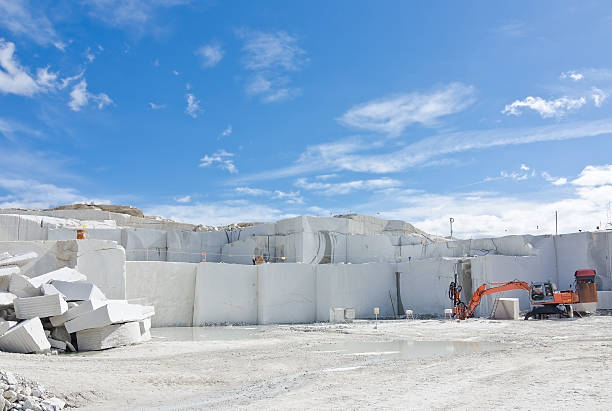Introducing the Mysteries of Granite Quarrying: Where Toughness and Elegance Meet
The world of granite quarrying is a world where the raw stamina of nature converges with human virtuosity to produce structures that stand the test of time with an air of style. From the depths of quarries to the meticulous polishing in workshops, the process of changing granite right into building marvels is a complex dancing of practice and development. As we peer right into the midsts of this ancient craft, we start to reveal the covert details that shape the extremely significance of our developed setting.
The Beginnings of Granite Quarrying
In the record of architectural history, the beginnings of granite quarrying are shrouded in a tapestry of old workmanship and geological wonders. Going back to ancient Egypt and Mesopotamia, the extraction of granite from quarries marked the start of a trip that would at some point lead to the creation of some of the world's most iconic structures.
Granite quarrying's origins can be mapped to the competent artisans who recognized the stone's sturdiness and aesthetic charm. With a combination of primitive tools and sheer resolution, these very early quarry employees unearthed granite blocks that would come to be the structure blocks of human beings.
As human beings advanced, so did the strategies of quarrying granite. The Romans, renowned for their design prowess, developed advanced methods for extracting granite to create monoliths, temples, and roads that stood the test of time.
The legacy of these old quarrying methods remains to shape modern style, with granite continuing to be a symbol of toughness and sophistication in construction tasks around the world. (granite quarries in south africa)
Tools of the Quarrying Trade
The evolution of granite quarrying strategies from old worlds to contemporary times highlights the vital role played by the tools of the quarrying profession in shaping the sector's methods. In ancient times, quarrying tools were basic, frequently including knives, hammers, and wedges made from products like bronze or iron. These tools required substantial workforce and time to extract granite obstructs from quarries.

Additionally, the introduction of pneumatically-driven devices and high-powered equipment has actually considerably decreased the physical labor needed in quarrying operations, improving worker safety and efficiency. As the quarrying market continues to innovate, the tools of the profession remain at the forefront of driving development and shaping the future of granite extraction.
Extracting Blocks of Granite
Using precision this hyperlink machinery and progressed methods, the removal of granite obstructs from quarries has become a sophisticated procedure in the modern-day quarrying sector. The preliminary action includes determining the place and size of the granite deposit to identify the most efficient extraction approach. Once a suitable website is picked, the removal procedure begins with the drilling of openings for the positioning of nitroglycerins. Managed blasting methods are after that utilized to disintegrate the granite into convenient sections.

Sprucing Up and Completing Techniques
To achieve a remarkable surface on granite blocks, skilled craftsmens utilize a collection of careful polishing and ending up methods. After the initial removal and shaping procedures, the granite obstructs undergo a thorough sprucing up phase to enhance their all-natural charm and durability. One usual technique made use of in brightening granite is diamond abrasion, where commercial diamonds are used to grind and brighten the rock to a smooth surface. This procedure not just creates a shiny surface however also makes sure uniformity in shade and texture across the granite block.
In enhancement to polishing, completing methods are used to further fine-tune the granite's appearance. These methods might consist of flaming, honing, or brushing, each offering one-of-a-kind structures and coatings to suit various visual preferences. Flaming, for instance, includes revealing the granite surface to heats to develop a rough, distinctive surface, perfect for exterior applications where slip-resistance is essential. Honing, on the other hand, offers a matte surface that is smooth to the touch, ideal for interior counter tops and floor covering. By meticulously picking and using these polishing and finishing techniques, artisans can transform raw granite blocks into splendid items that display both stamina and sophistication.

Environmental Influence and Sustainability
With the expanding emphasis on ecological consciousness in the market, granite quarrying methods are progressively inspected for their effect on all-natural sources and long-lasting sustainability. Quarrying for granite can have substantial environmental ramifications. The extraction procedure frequently entails making use of heavy equipment, nitroglycerins, and large amounts of water, bring about habitat damage, dirt disintegration, and water pollution. Furthermore, the transport of granite from quarries to refining centers generates carbon discharges, better adding to environmental deterioration. granite quarries in south africa.
To minimize these impacts and guarantee sustainability in granite quarrying, market stakeholders are taking on various measures. Executing sophisticated modern technologies to decrease energy intake and water usage, reclaiming quarried land for Get the facts ecological remediation, and advertising liable sourcing techniques are some approaches being used. Certifications such why not try this out as the Forest Stewardship Council (FSC) and the Leadership in Energy and Environmental Design (LEED) help consumers identify ecologically friendly granite items.
Conclusion
Finally, granite quarrying is a process that requires specialized devices and techniques to remove blocks of granite and polish them to a high level of surface. While the environmental influence of quarrying can be considerable, initiatives are being made to enhance sustainability practices in the industry. On the whole, granite quarrying is a fragile balance in between using the stamina and beauty of this natural rock while reducing its effect on the atmosphere.